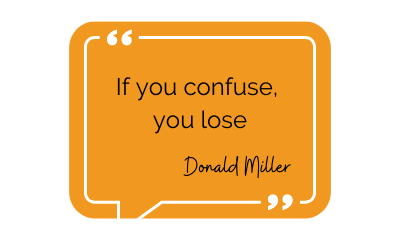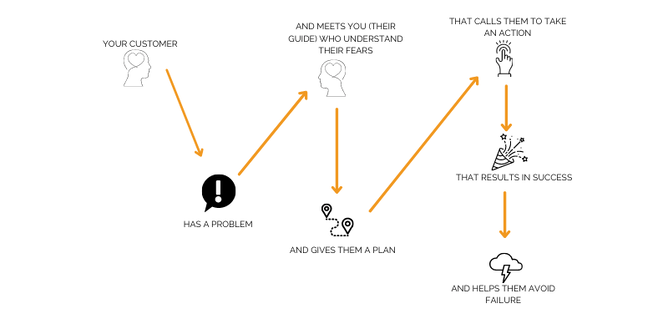How to grow your business with storytelling
We all love a good story. Billions of dollars spent on books and movies can’t be wrong. Maybe you have special memories of your family reading or telling stories to you before bed? We love a good story.
Did you know that stories can also help you build your business? I tell no fairy tales (look! Unicorn!)
Donald Miller, an American author created the StoryBrand framework. StoryBrand uses a 7-step framework to help businesses develop a clear business message that helps them connect with clients. As he succinctly puts it “if you confuse, you lose”.
So, what is this framework that StoryBrand uses?
StoryBrand uses a 7-step framework, that, if you work through all stages gets you all the messaging that you need to communicate clearly with your clients. Cutting through the noise. Helping you shout your message clearly in a crowded market place.
StoryBrand Step 1: A character
In business the character of our story isn’t us. (Sorry) It’s our client. Keeping our client front and centre means we’re automatically going to be talking to their needs. We want to invite them into a story where they can picture themselves. So we make our character (client) the hero of the story. To help our clients realise that we’re talking to them (as the hero), we have to talk to something they need or want.
The StoryBrand framework encourages us to think “What does our client want that relates to our business?”
- They want to feel confident in their own body
- They want to run without worrying about injuries
- They want to experience life without bloating and pain
StoryBrand Step 2: The character has a problem
All stories have a ‘problem’. Something that the hero of the story must overcome, solve, diffuse or achieve.
In StoryBrand they give Katniss from Hunger Games as an example. Her problem was how to stay alive! And Luke Skywalker from Star Wars. His problem? Defeating the Empire.
In health and wellness we have to give a bit more thought to our hero’s problem. It’s important for us to identify their problem, because that gives us information on how we can help solve it. It’s important for us to identify their problem because it also gives us the words they use to Google search solutions.
BUT. It’s also important that we use the problem in our story very, very carefully.
Why? In health and wellness years of health promotion campaigns have taught us that speaking to the problem doesn’t actually work. Why? Because people are often in denial about the causes of their problems, they want to blame others for their conditions (or not accept personal responsibility) or the goal seems too big, too hard, or too unachievable. There’s a heap of psychology going on there.
Now mainstream marketers know that talking problems hits up the primal brain and really gets people engaged. So they grab the pain and prod it until you can’t help but go “yes, yes, give me the solution”.
Believe me when I say that in wellness, this WON’T WORK (most of the time).
What will work is
- Identifying their problem (as it relates to your business)
- From this identify the opposite – the goal they want to achieve
- Speak to the goal achieved MORE than the problem experienced
- By defining the goal we help our clients to move towards us and engage us in business.
You can read more about this in my blog about the power of positive pain points.
StoryBrand Step 3: The character meets a guide who understands them
Ok, so now we can talk about you! StoryBrand (Seth Godin and I) encourage you to be the guide of your tribe. Your clients don’t want another hero in the story, they want someone who can show them how to solve their problems and achieve their goals.
To be a great guide there are a few things to realise
- It ain’t about you. Star Wars was about Luke Skywalker not Yoda
- You’re ‘job’ is to guide them towards a clearly defined goal
- You may be transient in their life. Once they’ve achieve the goal they move to another tribe
- A guide needs experience
- A guide needs authority
Authority and experience can be shown by client testimonials and reviews. In wellness this is a very grey area. If you can't use client testimonials because of legal restrictions, how do you show off your reputation?
- By speaking directly to the needs, aspirations and goals of your tribe through blogs, videos and podcasts.
- By using the words they use, problems they experience, goals they aspire to you can show empathy and experience.
- By communicating clearly with your tribe so they don't get lost on the way to experiencing the help you can give.
- By consistently being there for your tribe.
StoryBrand Step 4: The guide gives them a plan
A great guide has a plan already mapped out for the hero of the story to follow. Giving your hero a short map to follow will help them engage with you. Rather than let them wander aimlessly around your website, hoping they find out how to get involved with you, show them clearly what you want them to do.
StoryBrand encourages baby steps that show them exactly what will happen. Reassuring them you’ve got their back. Reduces confusion that they won’t know what to do or expect.
- 1. Start your free trial. 2. Enjoy regular guided yoga sessions whenever you want. 3. Sign up for the full package
- 1. Book a free call. 2. Discuss your health concerns. 3. Book a session with one of the team.
- 1. Order your supplements. 2. Await delivery eagerly. 3. Achieve your health goals
- 1. Complete our assessment. 2. We analyse your results. 3. We give you a tailored meal plan
StoryBrand Step 5: And calls them to action
Oh is this a biggie. You know that fear of being too salesy that we all have? Well guess what? Our clients are looking to spend money on you. Now that doesn’t mean you can go wheedling money out of them for no reason, but we (as business owners) have to realise that a) we want to help people b) they want to pay people for helping them c) if we don’t earn money we can’t help more people.
So at some point we have to call them to do something.
- Buy now
- Book now
- Learn how
- Schedule a free assessment
Sometimes though people just aren’t ready to jump in to bed with us. They want to get to know us more. This is where nurturing and guiding your tribe comes into its own.
This is StoryBrand, so you’re not the hero. Remind yourself you’re the guide. You have a plan to help people with their wellness journey. Everything you do revolves around getting them to the point where they can see your plan works and you’re the best guide for them.
Having a mini-step in the direction of a call to action can help us draw people from the edges into our tribe. Otherwise known as a ‘lead magnet’ or ‘transitional call to action’ this mini-step is your hero trading their email address for your value. It gives them a chance to check you out, get to know you, trust you.
Here’s an easy way to choose your transitional call to action:
Think of them main call to action that you want your hero to take.
What’s one step back from that which shows your value (solves a problem) but only requires a small commitment on the way to the full action you want them to take?
- If your main call to action is for someone to buy your aromatherapy massage package, a small step back may be a video showing someone how to do a stress-relieving foot massage on themselves, with a guide to what aromatherapy oils to use.
- If your main call to action is for someone to book an appointment for nutrition counselling for irritable bowel syndrome, one small step back may be a recipe book for no-bloating meals.
For more call to action tips, read this blog about how to write calls to action.
StoryBrand Step 6: The action helps them avoid failure
We don’t want our story to end in failure. Our hero wants to be a hero and that means overcoming, succeeding and getting the goal.
People are motivated by avoiding failure and achieving success in their life. But as we found out in step 2 (the problem), avoiding failure has to be carefully phrased for our wellness clients.
The right amount of talking about failure rather than success can be a fine line (but that’s why you’ve got me to help you). Too much talk of pain and failure will cause them to back off. But carefully structured, taking about avoiding a failure can be as powerful as achieving a goal.
Spelling out failures in the StoryBrand framework also helps you identify what happens to clients if they don’t go with your plan. This can make it easier for you to create a really compelling call to action or just empathise with what they risk if they don’t go with your plan.
StoryBrand Step 7: And ends in success
Of course the happy ending is a successful one in the StoryBrand framework for our business. But remember that it’s not our happy ending, it’s our hero’s happy ending. We get to tell them or show them what their life could be like when they’ve followed our plan, engaged with our tribe and purchased our products or services. When all our marketing has come together like a perfectly honed intercept mission.
This is the powerful vision. Did they use the force? Did they survive the Hunger Games? Did they get home from Oz?
Here’s how to think about what success you can give your clients
- How does your product or service transform lives?
- How does this make them feel?
- Make sure it’s achievable and realistic
- Use disclaimers (individual results may vary) if you need to
Using the StoryBrand framework to grow your business
So that’s the StoryBrand 7-step framework to creating a clear brand message for your business. Doesn’t it just make so much sense for our wellness clients?
As a StoryBrand certified guide I can help you create a strong, clear, compelling message that is sure to connect with your clients. Giving you the authority and empathy to be the best guide they can find. Growing your business along the way.
Ready to get the goodness of StoryBrand for yourself?
I work with Mammoth Marketing - New Zealand's StoryBrand guide.


